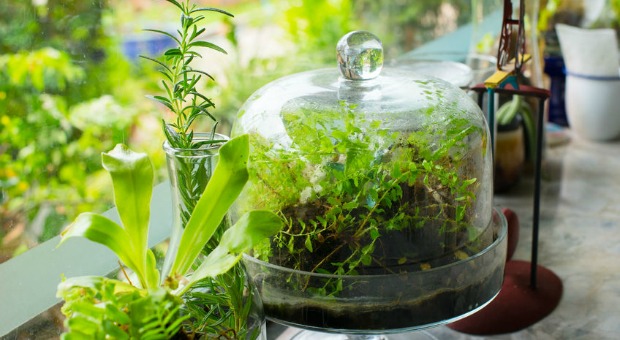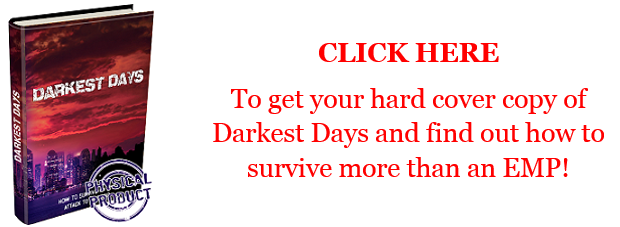When a crisis hits and it’s no longer safe to spend as much time outdoors, you’ll want to have a discreet garden to produce some food. You can create an indoor survival garden that’s out of sight of marauders inside of a terrarium.
While they are most often used for growing flowers and other non-edible plants, it is possible to grow food inside of a terrarium. Keep reading to find out out how to turn this mini-world into a food source for you and your family!
Once you get your terrarium built and your indoor garden established, it’s a low-maintenance, low-profile way to grow food. It’s also another way to keep your survival garden portable.
How to Choose Your Terrarium
A terrarium is a closed or almost closed mini-ecosystem, enclosed in a clear container. Depending on what’s inside, the lid will either fully or partially cover the bottle. The lid will help control the environment inside your terrarium.
To get your terrarium garden started, you’ll need some supplies. Many can be repurposed from around the homestead.
For each terrarium you’ll need:
- A clean, clear container with a wide top and a lid such as:
- A large mason jar
- A cake stand
- A gallon pitcher
- An aquarium
- A plastic deli container
- Activated charcoal pieces or an aquarium filter
- Potting soil that drains well
- Enough pebbles to line the bottom of the container a by ½ inch
- Sphagnum moss
- Your desired plants and seeds (more details below)
- A spray bottle for misting
- Plastic wrap to cover the top if your container’s lid is missing or doesn’t cover tightly.
How to Assemble Your Terrarium
You’ll need four layers at the bottom of each terrarium. They are each essential to creating a healthy, low-maintenance system.
First, place a layer of pebbles or cleaned gravel at the bottom of your container. This layer allows drainage from the upper layers, and prevents your plants from rotting at the roots.
The second layer is a thin layer of activated charcoal. You can also use a piece of aquarium filter cut to size. The charcoal absorbs odors from the decomposition that’ll happen as your garden grows and keeps the soil clean.
If your plants don’t need a tropical environment, you can skip the charcoal. For these plants, you’ll be leaving the lid off of your terrarium at least partially, and the fresh air will keep the odor down.
Next you’ll add a layer of sphagnum moss. This moss is often found in swampy areas, and is also known as sheet moss. It will prevent the soil on top from making its way down to the filtering material.
Your final layer before adding plants is potting soil. You’ll want soil that stays well drained. A soil mixture comprised of peat moss, vermiculite and perlite works really well for growing in small spaces.
The soil needs to be deep enough to accommodate root growth. Three inches is a good starting point, though you can adjust this based on the plants you are growing.
Before planting, you’ll want to pack down your terrarium’s base as much as possible. You can use your hand, or a small gardening tool that’ll fit inside your container. A hand-held potato masher also works.
This packing process will remove air pockets in the soil and gravel, and help your plants grow better. Once packed, your soil and drainage materials should take up about a quarter of your terrarium container.
What to Grow in Your Terrarium?
Now your terrarium is ready for plants. You can either plant seeds or transplant seedlings to the container you prepared.
The size and shape of your container will dictate what sorts of plants you can grow. For instance, dwarf fruit trees can be planted in a tall terrarium, but not in a short, horizontal shaped one.
Not every plant is suited for terrarium growth. You want slower growing plants that won’t grow bigger than your container. Here are some that gardeners have had success with:
- Dwarf tomato plants
- Dwarf blueberry plants
- Herbs such as mint, thyme, and oregano
- Spinach
- Lettuce
- Arugula
- Green onions
- Creeping figs
You’ll find many of these plants on this Survivopedia post on the most nutritious food to grow in your survival garden. While you won’t be growing on a large scale in a terrarium, you can grow nutritious food that’ll help you survive a SHTF scenario.
While herbs won’t add a lot of nutrients to your plate, they’ll help ensure that your survival food actually tastes good. There are also plenty of medicinal uses for herbs, making them extremely valuable in a crisis.
Here is a list of 10 survival foods you should grow.
How to Arrange Plants in Your Terrarium
You don’t want to overcrowd your terrarium, so you’ll want to arrange your plants carefully. Remember that your plants will grow, so be sure to leave enough space between them.
If you’ll be planting multiple kinds of plants in a single terrarium, make sure they’re compatible. You’ll want to check:
- Heat tolerance and needs
- Water needs
- Light needs
Once you’ve decided what to plant in each terrarium, plant the tallest plant first. This will ensure that you can look in the front and visually inspect each of your plants. It’ll also make it more appealing to look at.
When your plants are in, it’s time to water. You’ll want to use your spray bottle so you have better control over how much water is added. It won’t take much to get your soil damp, but not soaked.
Creating the Proper Environment
Your terrarium can produce a wide range of environments. If your plants need a tropical, warm and wet environment, leave the lid on almost all the time. This will hold the heat in and allow the water to condense. It’ll be an almost completely self-sufficient system.
But, not all plants thrive in such an environment. To make your terrarium more temperate, simply leave the lid partially off. This will allow fresh air to enter and keep the whole container cooler.
If your home’s interior temperature is warm, you may even take the lid off completely. This will make your terrarium behave more similarly to any other container-style garden.
Factors to Consider When Creating the Proper Environment
Sunlight
You don’t want to boil your plants, so keep your terrariums out of direct sunlight. Otherwise the sunlight can heat the water inside to extremely high temperatures.
It’s much better to allow your plants to receive indirect sunlight. So place them next to the window instead of in the windowsill. This will also make your garden terrariums harder to spot from anyone who passes by.
Water
Closed system terrariums need very little water because it recycles the water through the water cycle. A light misting once a month will be all you need to keep the soil moist.
Partially closed or open terrariums will require more frequent watering because some water will be lost to evaporation. Keep an eye on your soil, and ensure it stays damp.
Plant Size
You’ll want to keep an eye on your plants and ensure they aren’t getting too large for your container. If they are, prune them back a little to help them focus their effort on producing fruit. If your plant starts touching the edges of your container, you’ll want to move it to a larger sized container.
5 Common Problems with Terrariums
Though terrariums are fairly low maintenance once you get them established, you may run into problems. Here are five of the most common signs to watch for, and what to do for each:
1. Root Rot or Moldy Plants
Overwatering can cause root rot or mold to form on your plants. If you notice this, let your terrarium receive fresh air to dry out for a day. Then, don’t water your terrarium again until the soil is dried out.
Add just a bit of water and ensure there isn’t standing water at the bottom of your container. That’s a sign of too much water.
2. Shriveled Plants
Though terrariums don’t need much water, it is possible for them to be under watered. If you notice your plants beginning to shrivel, the first thing you should do is check the soil.
You want it to feel slightly damp about an inch down. If your soil is dry, it’s time to add some more water. Depending on the ecosystem you’re creating, you may need to readjust your watering schedule.
3. Too Much Light
If your terrarium is receiving too much direct sunlight, you’ll start to notice burn spots on your leaves. If you aren’t able to move your terrarium to a slightly darker location, try covering it with a paper bag during the hottest part of the day. This will ensure the glass isn’t able to magnify the light and create an extreme condition inside.
4. Not Enough Light
Plants that aren’t getting enough light will start to look pale. They’ll also start stretching, growing towards the sunlight. While all plants will naturally grow towards the sun, ones that are deprived will have an unnatural, stretched out look.
If your plants need more light, you can either move them to a sunnier location (though not in direct sunlight) or provide artificial light each day.
5. Mineral Buildup
If you use tap water to water your terrarium, you may notice a build-up on the glass. This is typically caused by the salt and minerals in your water.
Using captured rainwater or distilled water will keep this from getting worse in the future. These types of waters will also ensure that your soil isn’t developing a buildup of salt that’s harsh on your plants.
Here is an example of how to take care of your tomato plant in a terrarium garden:
Video first seen on ehowgarden.
Start Your Terrarium Gardens Now
If growing your own food indoors in a terrarium sounds appealing, you should start one now. That way you’ll be able to experiment and see what grows best in the environment you create.
Starting now, before a crisis hits, will also ensure that your plants are established and producing when you need them. You’ll make sure you have everything you need and that you can do your troubleshooting now.
So grab a container, and the other supplies you need and start experimenting. You’ll be amazed at what you can grow in such a small, low-maintenance system.
Have You Grown in a Terrarium Before?
I know I didn’t cover all the intricacies of growing in a terrarium in this post, so if you have more information to share with your fellow readers, please do so in the comments below! Be sure to share what you grew, and if you used a closed, partially closed, or open system. That way everyone can benefit from your knowledge and experience.
This article has been written by Lisa Tanner for Survivopedia.











Pingback:Small Spaces Survival: Growing Food Upside Down | Survivopedia | December 18, 2017
|